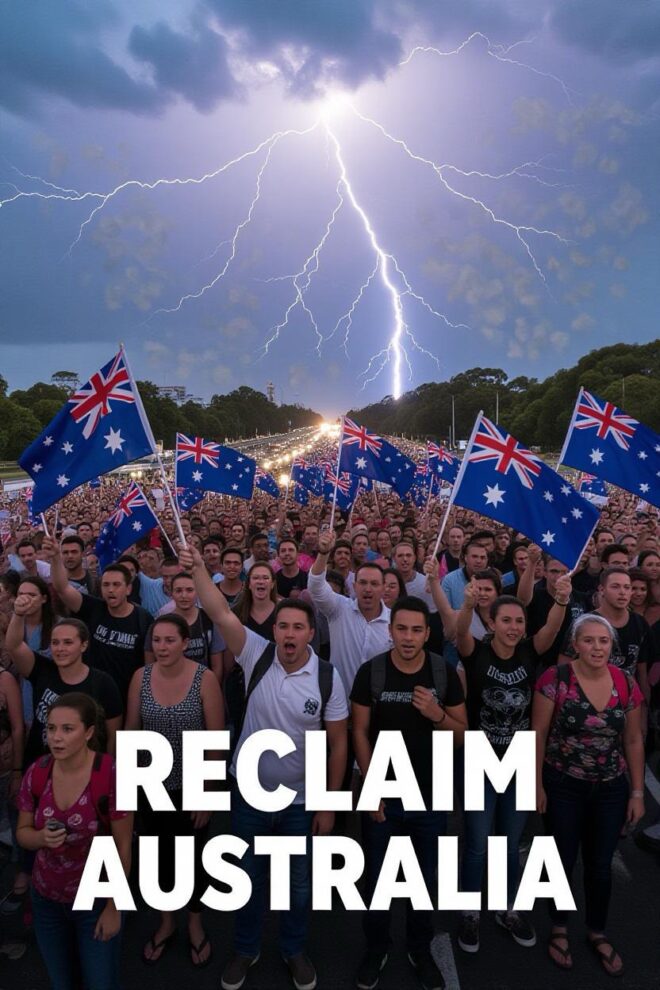
Introduction
On August 31, 2025, thousands of Australians are set to converge in major cities for what organisers have dubbed the “March for Australia.” Billed as a grassroots movement to “take our country back,” the protests aim to halt what participants describe as unchecked mass immigration, reclaim national identity, and restore a sense of unity under the Australian flag. Event flyers and social media posts emphasise demands for slashing immigration numbers, prioritising housing for locals, and combating economic decline, all while insisting the rallies remain peaceful and free from foreign influences or extremist agendas. Yet, critics, including influencers like Abbie Chatfield and demographers such as Liz Allen from the Australian National University, decry the movement as thinly veiled racism, xenophobia, and a magnet for neo-Nazis attempting to hijack the narrative.
This event echoes the 2015 Reclaim Australia rallies, a far-right campaign against Islam that drew thousands but ultimately splintered amid internal divisions and public backlash. The 2025 iteration, while rebranded and ostensibly broader in scope, taps into similar veins of discontent: fears of cultural erosion, economic displacement, and a longing for an idealised Australia of yesteryear—a “fair go” nation unmarred by diversity or global pressures. However, this vision of the past is largely mythical, a romanticised construct that ignores Australia’s history of colonialism, racial exclusion, and ongoing inequalities. More critically, the grievances fuelling the march, skyrocketing housing costs, cost-of-living pressures, and per-capita economic recession, are real and pressing, but they stem not primarily from immigration but from decades of policy failures, investor tax incentives, and inadequate infrastructure planning.
This essay argues that the March for Australia represents a misguided quest to reclaim a past that never truly existed in its idealised form, driven by a profound misunderstanding of the underlying issues. By examining the historical precedents, the current movement’s dynamics, the fabricated nostalgia, and the actual socioeconomic drivers, we can see how such protests divert attention from systemic solutions. Drawing on expert analyses, media reports, and public discourse, it becomes clear that addressing these grievances requires confronting economic inequalities head-on, rather than scapegoating migrants. In an era of fragile social cohesion, amplified by misinformation, events like this risk deepening divisions without resolving the core problems plaguing everyday Australians.
Historical Context: The 2015 Reclaim Australia Rallies
The march’s origins trace back to online calls for action amid post-COVID economic woes. Organisers have emphasised that the event is a grassroots rally against government mass immigration policies, which they claim mask a broken economy amid a cost-of-living and housing crisis. This sentiment resonates with many feeling squeezed by rising rents and stagnant wages, yet it overlooks how immigration has historically bolstered Australia’s economy. Recent developments, as of August 18, 2025, show the movement gaining traction, but also facing internal and external challenges, including attempts by far-right figures to co-opt it and government condemnations. As we delve deeper, the essay will unpack these layers, revealing a movement built on illusion rather than insight.
To understand the March for Australia, we must first revisit its ideological predecessor: the Reclaim Australia movement of 2015. Formed in the wake of the Lindt Café siege in Sydney, which heightened fears of Islamic extremism, Reclaim Australia organised nationwide rallies protesting against “sharia law, halal tax, and Islamisation.” The group positioned itself as defenders of Australian values, drawing crowds in cities like Melbourne, Sydney, and Brisbane. At its peak, rallies attracted thousands, with speakers including controversial figures like Pauline Hanson, who declared, “Criticism is not racism,” and Danny Nalliah, a pastor who warned of “Islamic barbarity.”
The grievances articulated by Reclaim Australia were multifaceted but centred on a perceived threat to Australian cultural identity. Protesters decried minority groups attempting to “change the Australian cultural identity,” advocating for bans on Islamic practices and expressing outright Islamophobia. Rallies often featured Australian anthems like John Williamson’s “True Blue,” symbolising a yearning for a homogeneous, pre-multicultural Australia. However, this nostalgia was selective; Williamson himself distanced his song from the group, stating it was being misused by those promoting “discrimination, segregation, paedophilia disguised as marriage, hatred of Gays.”
Critically, Reclaim Australia attracted far-right elements, including neo-Nazis from groups like the United Patriots Front (UPF), a splinter faction that emerged amid internal splits. In July 2015, organisers in Brisbane announced a breakaway to form a more explicitly anti-Islamic entity, while federal backbencher George Christensen welcomed the “weeding out” of anti-Muslim extremists—ironically, after speaking at a rally himself. Clashes with counter-protesters, including anti-racism activists and trade unionists, turned violent in places like Melbourne, where police arrested dozens.
The movement’s ideology was rooted in a mythical past: an Australia of “mateship, freedom, and fair go,” untainted by immigration. Yet, this vision glossed over Australia’s colonial history, including the White Australia Policy (1901-1973), which enforced racial exclusion while perpetuating Indigenous dispossession. Reclaim Australia’s protests were not just anti-Islam but anti-diversity, ignoring how multiculturalism had enriched the nation since the post-WWII era. By 2017, attendance dwindled, with a Sydney rally drawing only dozens, signalling the group’s decline. However, its rhetoric lingered, influencing later far-right activities and setting the stage for revivals like the 2025 march.
The Islamophobia in Australia Report noted that such rallies were symptoms of deeper social issues, including economic insecurity and misinformation. The 2015 events highlighted how grievances, real fears of terrorism amplified by media, were channelled into bigotry, diverting from addressing root causes like inequality. This pattern persists today, as the March for Australia repurposes similar narratives in a post-pandemic context, with added layers of economic frustration post-2020 lockdowns.
The 2025 Revival: March for Australia
Fast-forward to 2025, and the March for Australia emerges as an apparent revival of Reclaim Australia’s spirit, albeit under a new banner. Planned for nine cities on August 31, the protests call for an end to “mass immigration” and a reclamation of Australia’s identity, with slogans like “Take our country back.” Organisers, anonymous but vocal on various platforms, emphasise unity: “We’re Aussies. Real ones. The kind who believe in mateship, freedom, and fair go.” Demands include slashing immigration, taxing multinationals, housing the homeless, and reversing per-capita GDP decline.
Unlike 2015’s explicit anti-Islam focus, the 2025 movement frames immigration broadly as masking economic failures. Organisers claim the government has failed citizens, including the Indigenous population, treating them like second-class citizens. Yet, echoes of the past remain: bans on foreign flags and warnings against “foreign influence.” Critics point to neo-Nazi involvement, with figures like Thomas Sewell of the National Socialist Network attempting to claim the event, prompting organisers to distance themselves. Sewell described it as a rally for “White Australians” to assemble against immigration.
Media coverage highlights the controversy. SBS News reports the marches as “anti-immigration protests” fuelled by misinformation, with demographer Liz Allen noting, “Australia doesn’t need to import racism. Australia has its own homegrown racism.” The Guardian warns of dog-whistling attracting extremists, citing flyers with Union Jack imagery implying a return to colonial roots. Abbie Chatfield blasted participants as “f***ing freaks,” labeling the rallies “racist, bigoted, disgusting.” Government ministers have condemned the events, stating that protests vowing to ‘take our country back’ have no place in Australia.
Public discourse amplifies divisions. Supporters urge standing united to fight for the country, while detractors expose white supremacist undertones. Police are on alert, anticipating clashes similar to 2015. Revelations about one organiser from a wealthy property family tied to a real estate developer add irony—he profits from the housing market while protesting immigration’s role in it. This has led to media “hit pieces” that some say backfired, boosting support.
The revival is timely, amid post-COVID migration surges and economic strains. Net overseas migration hit record highs in 2023-24, but experts argue it’s recuperative, not causative of crises. The march’s grievances—housing shortages, cost-of-living hikes—are valid, but the blame on immigrants misdirects from policy shortcomings, perpetuating a cycle of misunderstanding. Supporters insist the event is “bigger than the organisers,” with calls to ignore neo-Nazi claims and focus on unity against government policies. Warnings about scams pretending to collect donations for the march further highlight the chaotic online organisation.
Deconstructing the Mythical Past
At the heart of the March for Australia lies a yearning for a mythical past: an Australia of unbridled prosperity, cultural homogeneity, and egalitarian “fair go.” Organisers evoke this through references to “Australian values” and flags, implying a return to pre-immigration bliss. But this past never existed as portrayed; it’s a fabricated narrative ignoring historical realities.
Australia’s foundational myth centres on the “lucky country,” but from European settlement in 1788, it was built on Indigenous dispossession and convict labour. The White Australia Policy enshrined racial purity until 1973, excluding non-Europeans while exploiting Pacific Islanders in blackbirding. Post-WWII migration waves, from Italians and Greeks to Vietnamese refugees, diversified the nation, but not without resistance. The 2015 Reclaim rallies romanticised this era, playing songs like “True Blue” to invoke a blue-collar, white Aussie identity.
Yet, even in the “golden years” of the 1950s-1970s, inequalities abounded. Women faced wage discrimination, Indigenous Australians were denied voting rights until 1962, and economic booms masked regional poverty. The “fair go” was selective, as evidenced by the Stolen Generations and institutional racism. Critics argue that certain patriotic Australians claim to “reclaim” their heritage while ignoring their own settler roots.
In 2025, this myth persists, with marchers decrying “erasure” of culture amid immigration. However, multiculturalism has been policy since the 1970s, contributing to GDP growth and innovation. Experts like Rebecca Huntley note Australians have “lost hope in the fair go,” but this stems from inequality, not diversity. The mythical past serves as a scapegoat, allowing grievances to be externalised rather than addressed internally. Recent discussions question inclusivity, with migrants wondering if they are welcomed despite long-term residency, highlighting how the rhetoric alienates established residents.
Historical parallels abound: the 2015 rallies feared “Islamisation,” mirroring 2025’s anti-immigration fears. Both ignore how Australia has always been shaped by waves of newcomers, from gold rush Chinese to modern skilled migrants. Deconstructing this myth reveals the march as nostalgia for exclusion, not progress. Satirical commentary highlights the hypocrisy of recent migrants wanting to deport others who arrived shortly after.
The Real Issues Underpinning Grievances
While the March for Australia attributes woes to immigration, the real drivers are entrenched economic policies. Australia’s housing crisis, with prices hitting $912,700 on average, predates recent migration surges. During COVID border closures, when net migration plummeted, house prices rose 25%. Experts like those from the Australia Institute assert, “Migration is not to blame for house prices rising.”
Key culprits include the 1999 capital gains tax discount and negative gearing, which favour investors, inflating prices by 70% over a decade while dwellings grew only 19%. Supply shortages exceed 1.3 million units since 2001, exacerbated by underinvestment in social housing (just 4% of stock). Cost-of-living pressures, high energy, food, and taxes, stem from multinational tax evasion and climate policies, not migrants.
Per-capita recession reflects stagnant productivity, with migration actually boosting GDP. Lowy Institute polls show 53% view migration as “too high,” but this fear is misplaced. Cutting migration could cost billions in lost revenue, worsening issues. Internal migration to Queensland amplifies local strains, but overall, immigration’s impact on housing is marginal.
Grievances like homelessness and job competition are valid, but misattributed. As Liz Allen states, “The root cause is fear… tackling housing, economic security, gender equality, and climate change.” The march’s focus on immigrants distracts from these systemic failures. Politicians like Tony Burke, who owns six properties, criticise the march while benefiting from the policies driving shortages, underscoring elite hypocrisy.
The Role of Media and Government in Shaping the Narrative
Media and government responses have played a pivotal role in framing the March for Australia, often amplifying divisions. Outlets like News.com.au attempted hit pieces on organisers, revealing ties to a property empire, but these reportedly backfired, rallying more support. Crikey noted the movement’s momentum among anti-lockdown and nationalist groups, only disrupted by neo-Nazi claims.
Government ministers, including those from Labor, have outright condemned the rallies as un-Australian, with Tony Burke leading the charge despite his property portfolio. This top-down dismissal ignores legitimate economic concerns, potentially alienating voters. Public sentiment counters this, with some decrying double standards in how protests are treated.
Such responses risk polarising society further, as seen in recent Gaza protests drawing massive crowds without similar backlash. Anti-protest laws are being challenged, signalling a return to 1960s activism spirit. The media-government nexus thus contributes to the misunderstanding, portraying the march as extremist while downplaying systemic issues.
Misunderstanding and Misinformation
The march’s momentum thrives on misinformation, amplified by online discussions. Claims of immigration causing crises ignore data showing prices rose during low migration. Echo chambers perpetuate myths, with calls like “ENOUGH IS ENOUGH” gaining traction. Allegations of white supremacist organisers have sparked debates, with some urging transparency. This lack of understanding, fuelled by fear rather than facts, undermines solutions like tax reform. Supporters counter by emphasising inclusivity, but the spread of scams and infighting reveals vulnerabilities in grassroots organising.
Conclusion
The March for Australia, like its 2015 forebear, chases a mythical past of unity and prosperity that overlooks historical flaws. Driven by real grievances, housing unaffordability, economic stagnation, the movement errs in blaming immigration, diverting from policy fixes. Media and government reactions exacerbate divisions, while online discussions fuel misinformation. To reclaim a better Australia, we must address root causes through inclusive reforms, fostering hope over division. Only then can the “fair go” become reality for all, uniting diverse voices in genuine progress.


